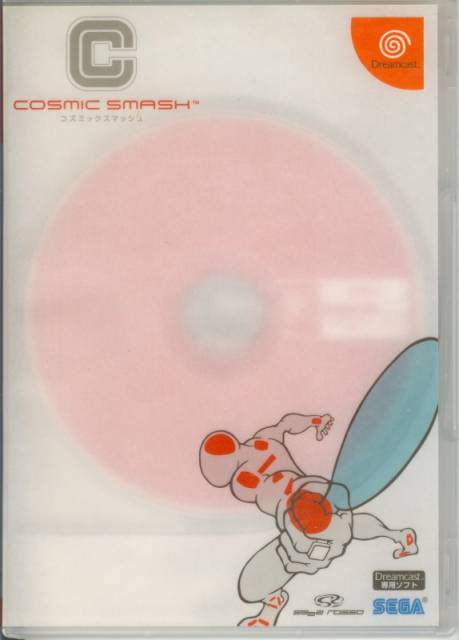An Addicting, Albiet Shallow, Entry into the Dreamcast Library.
[NEGATIVES]: (Completing every level in a single run is not even an option. Glowing orb makes percieving depth difficult sometimes. Bare in terms of gameplay modes and extras. No multiplayer.)
Sega has proved its mastery of the arcade gaming genre time and time again, both in its actual arcade and console releases, as well as in its ports between the two. Cosmic Smash, developed by Sega Rosso, qualifies as the latter. Originally a physical arcade title, Cosmic Smash for the Dreamcast is a direct port of that original game, "direct" being the most critical term. The game has changed very little (if at all) in its translation onto the little white box.
In Cosmic Smash you take control of a nameless, faceless, semi-transperent character wielding a racket and armed with a glowing red orb. In classic arcade fashion, the game is seperated into several different levels, varying in difficulty and intensity. Each level consists of an enclosed room and a set number of blocks that must be destroyed in order to advance to the next level before your timer runs out. To destroy each set of blocks, you need to hit each of them using the orb you strike with your racket. Think of it as a hybrid of racquetball and Breakout. Additionally, each type of block has its own set of physical properties. Some blocks may only require a single strike with the orb to destroy it, while others may require multiple strikes, and still others will allow the orb to pass through more than one block as opposed to having to strike each one seperately. In the case of one flashing block, when struck by the orb, it will release several other orbs to destroy surrounding blocks. This changing set of properties adds some variety to the game in the short term, and it's interesting to find out all the game's different blocks and effects, but after a few playthroughs it becomes standard fare, just another way to finish a level.
Graphically, Cosmic Smash is very sound. The game has good, smooth geometry, and a varying color palette, but what gives the game a unique look is the art style. The visuals are as minimalistic as humanly possible without detracting from the experience. In fact, the glowing colors and sterile textures do more to enhance the experience than to hamper it. The animation is very smooth, save for a few rare instances with the player's movements. Miscellaneous graphical effects, such as the gears spinning inside our transperent player model, the glow of the orb, or the particle effects of disappearing blocks, are very well done without being overused or overblown.
On the audio front, the game maintains its minimalistic feel. The game has an odd announcing choice, touting a mix of two voices. But instead of having, say, a high voice and a low voice, Sega has gone with a laid-back English-speaking male and a relaxing Japanese-speaking female. It's a unique mix, and it lends itself well to the rest of the odd, artistic presentation of Cosmic Smash. The game's soundtrack is comprised of a few techno tracks that work well with the game's pacing, mixing a casual drone with a relentless beat, contrasting the game's casual style and unrelenting timer.
At the outset of a level, you have a timer with a set number of seconds that count down as the level begins (the amount of time you get can be altered in the options menu). If you complete the level before the time runs out, that time is added to the next level's timer. During gameplay, your player can perform a few special moves, including a move that allows your orb to break several blocks but also drains your timer. After each level you choose a direction in which to go on the level map. Having the option available for which levels to complete and in what order give the player a sense of freedom, though the ability to turn around and complete more levels once you reach the end of a path would have been a nice bonus. These aspects give veteran players an edge and allow them to exercise a bit of strategy in their gameplay.
My biggest problem with the game is the lack of alternative gameplay modes. This brings us back to the term I used at the outset of this review: Direct port. With the exception of the options menu, the game is almost identical to its original arcade form. This means that you only get the one level-based arcade mode. There is so much that could have been done with the game's concept. There could have been a marathon mode, where a player just keeps destroying more and more blocks until he loses a ball. There could have been a "beat" mode, where each level speeds up the play until its almost unbearable. There could have been a challenge mode, where you need to destroy only a certain few blocks or use a certain trick to complete a stage. Most of all, there could have been a cooperative or competitive multiplayer game here, with both players clearing a single field of blocks or fighting to clear their board before the other player, or have a game where if you destroy a block on your field, it would appear on the other player's field, and vice-versa.
However, even with the wealth of possibility for alternation that this game posesses, Sega did nothing more than port over a great arcade game to their own console. But with the initial release price being a measly 2800 yen ($23), and being available for much cheaper nowadays, porting this great game over onto the Dreamcast completely intact doesn't make it any less enjoyable.

0 Comments